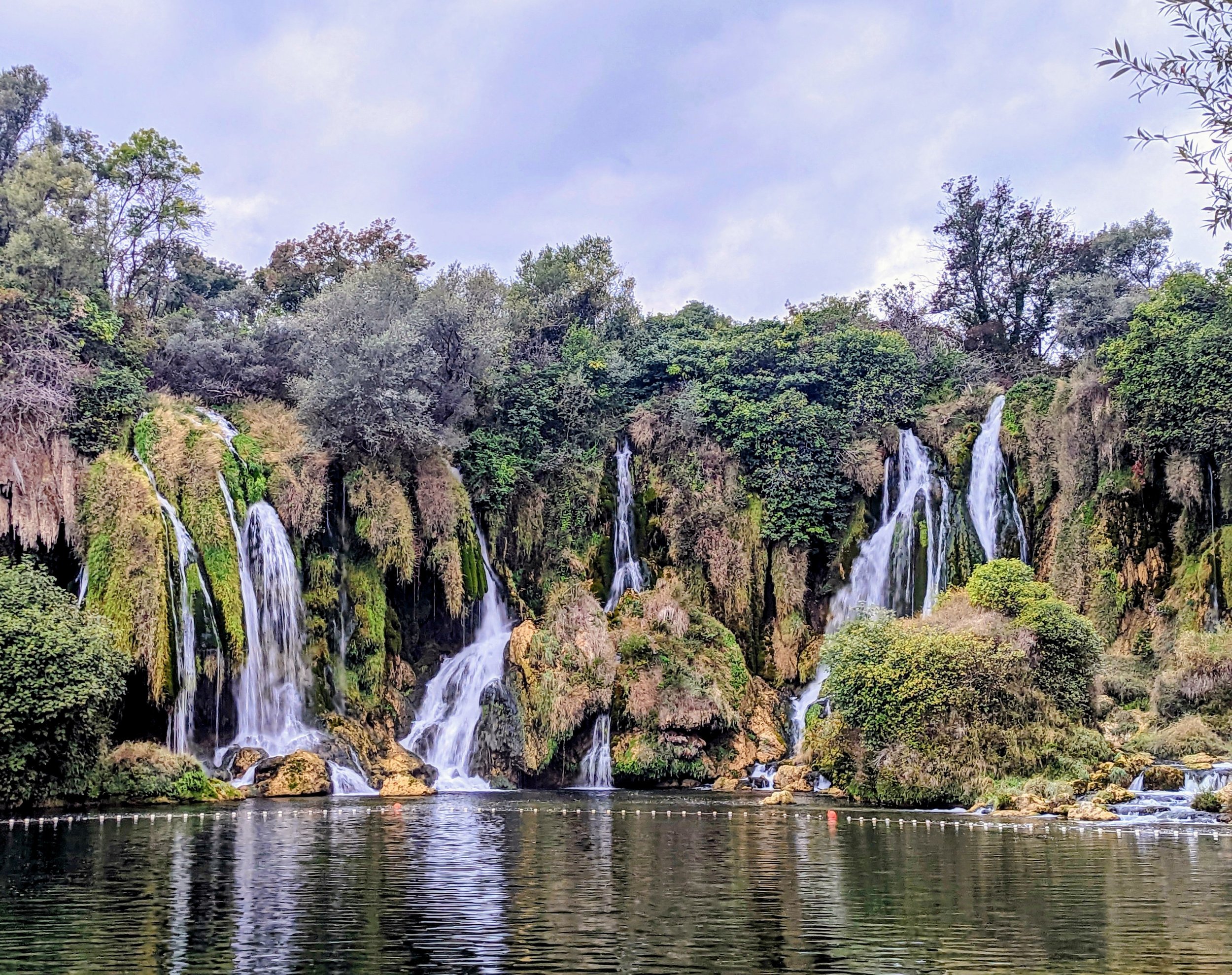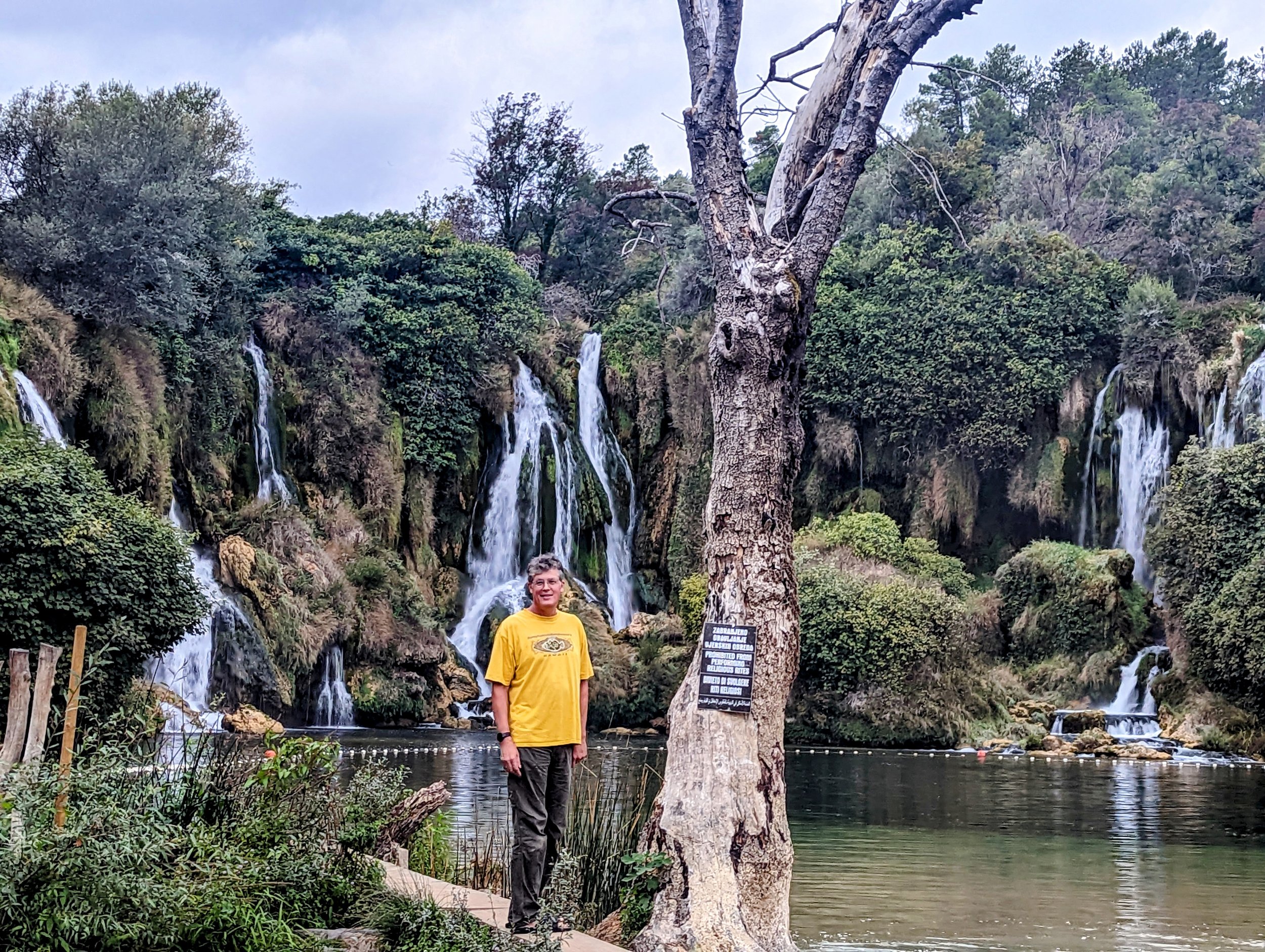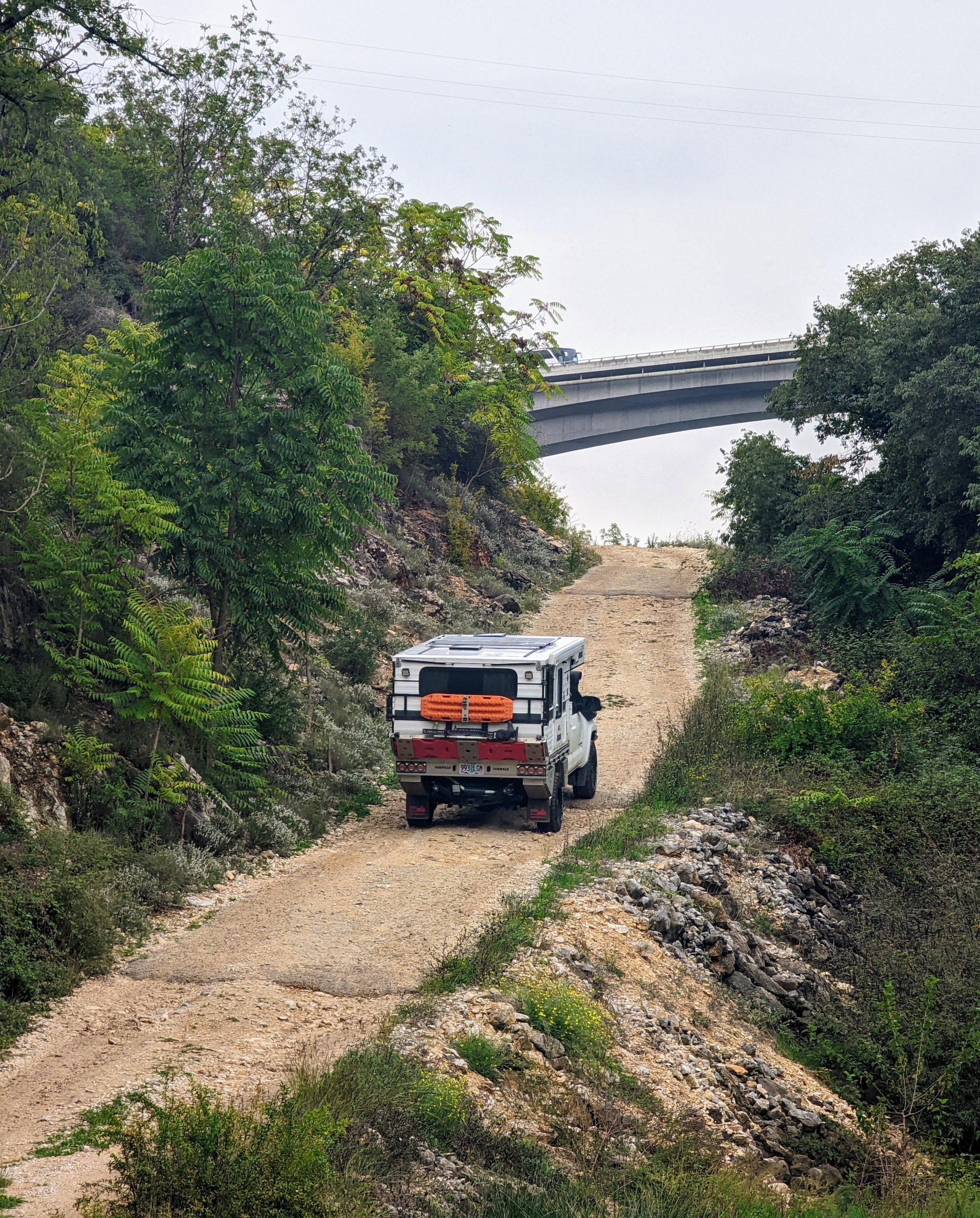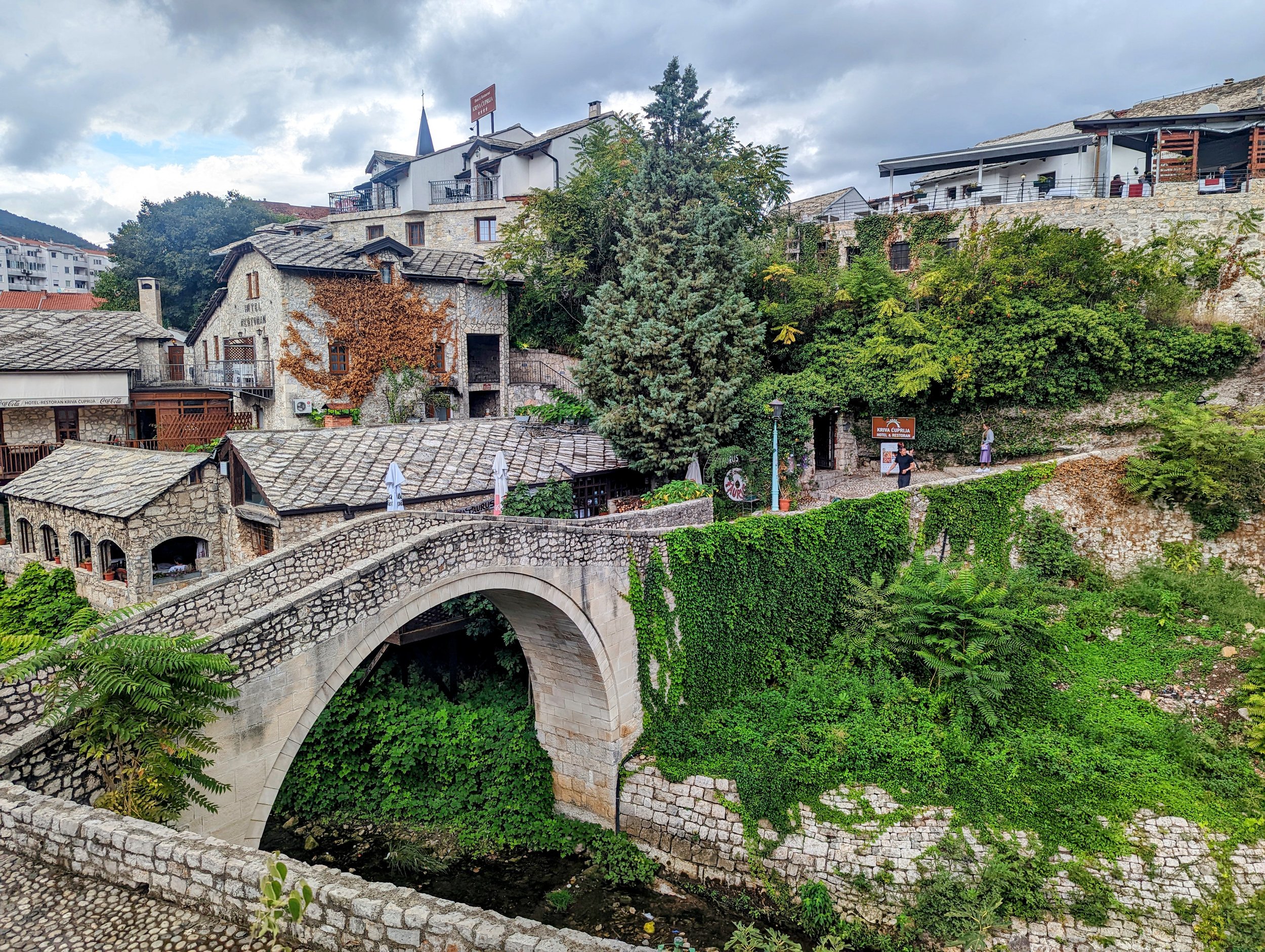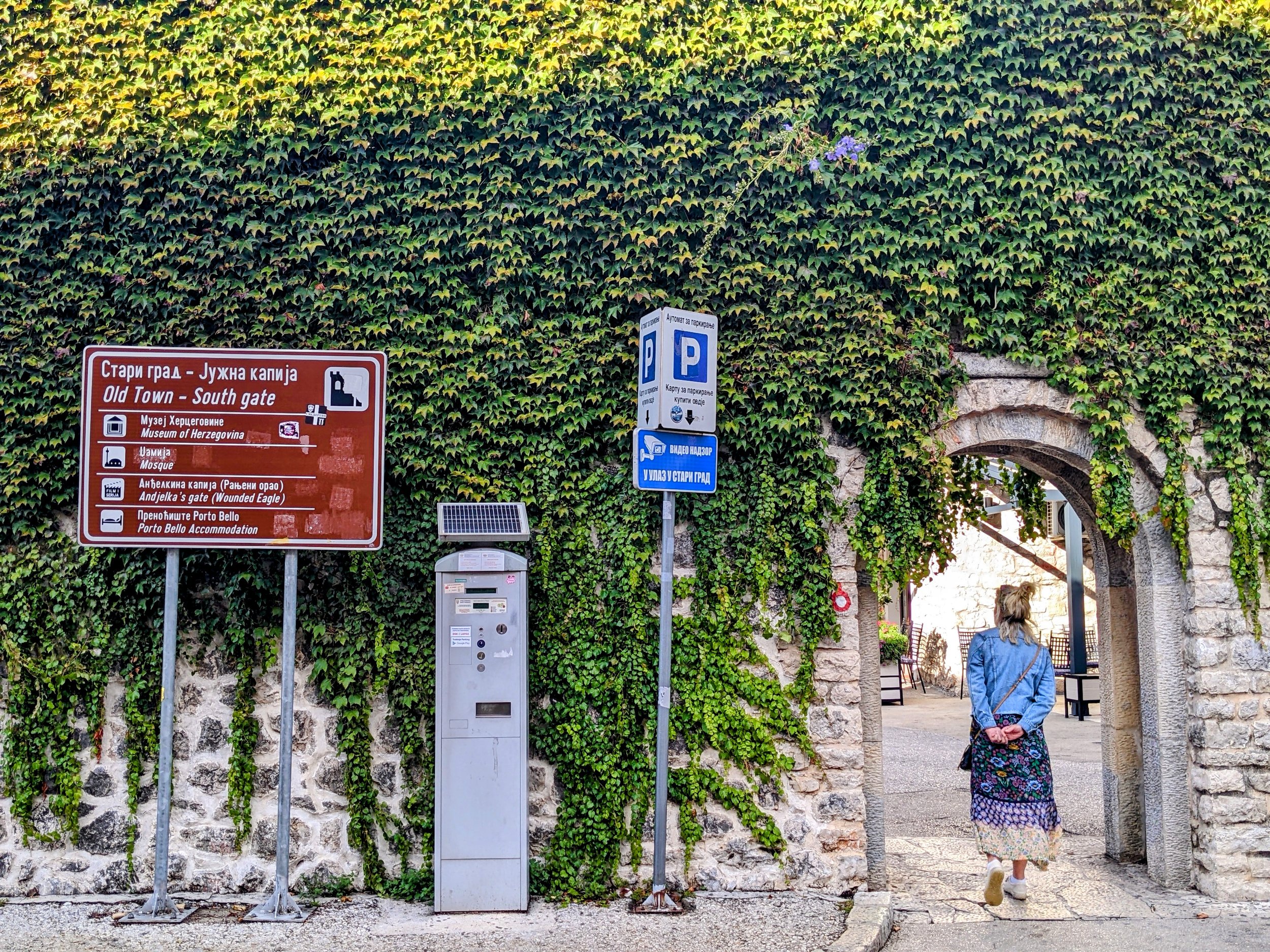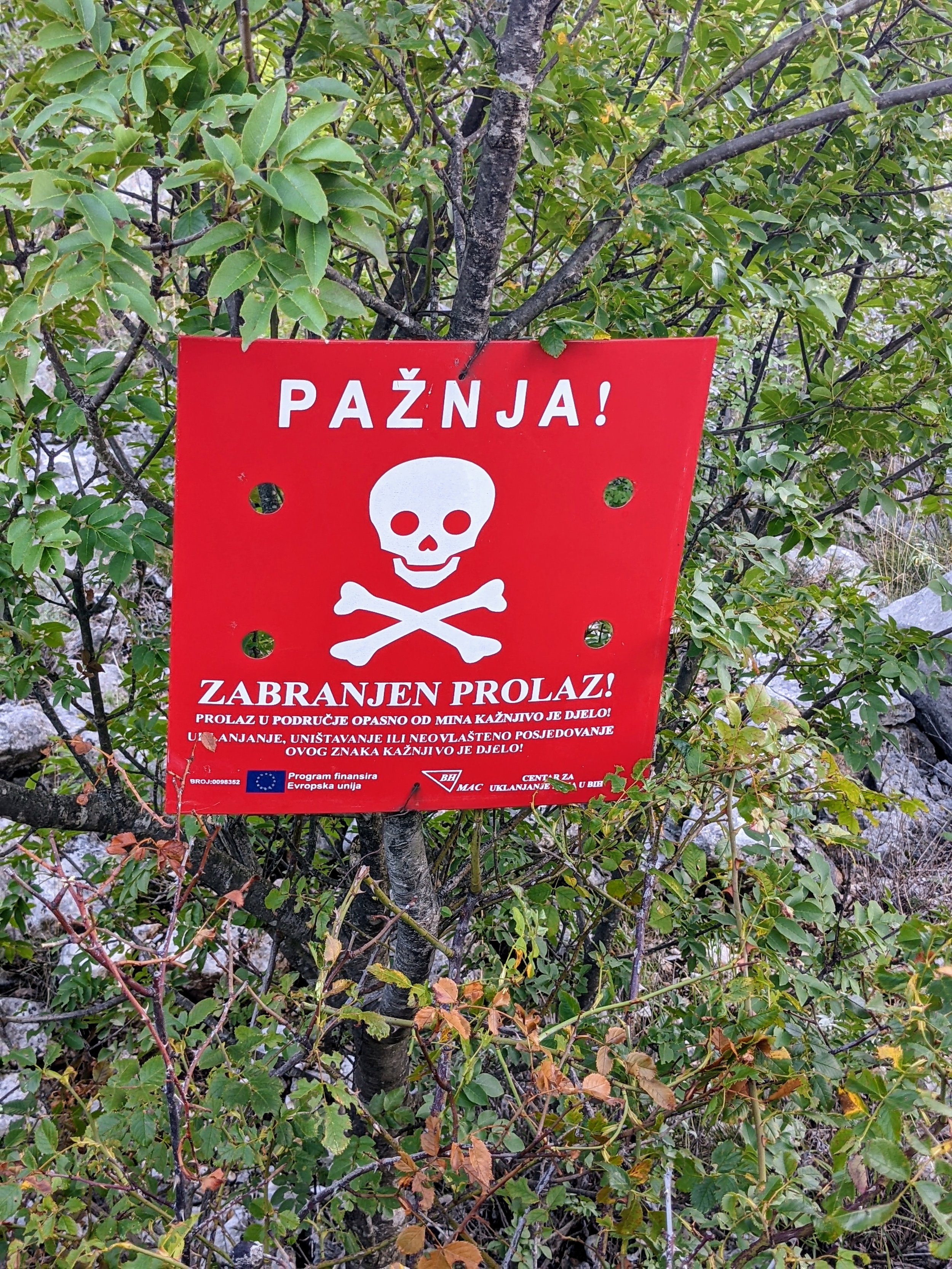Bosnia and Herzegovina
Old bridge in Mostar, Stari Most
Bosnia and Herzegovina was a country that we did not know much about and we were unclear what to expect. In our lifetime memories, the name is largely associated with hearing news about war and conflict between the majority Bosnian Muslim population who were seeking independence from the former Yugoslavia and the Bosnian Serbian Orthodox people seeking to retain ties to it. We followed the collapse of Yugoslavia from afar, not really understanding all the complicated history and factors that led to the final split between the three major groups: Croats, majority Catholic and aligned with Western Europe, Serbs, majority Orthodox and aligned with Russia, and Bosniaks, traditionally Muslim. We had heard with horror about the ethnic cleansing occurring across the region and NATO’s stepping in. Today, the Dayton Accords that brought peace to the region, signed by the three groups, still holds and the younger generations seem hopeful about positive change and healing.
The signs of war are still present in the occasional bombed building, or signs warning about unexploded land mines. With the war ending 27 years ago, it is still very much in the current generations’ memories. As one young person put it, three generations in Bosnia have lived in three separate countries, even if all from the same house. Pre WW2, Bosnia was part of the kingdom of Yugoslavia, a monarchy. Following WW2, the Russians liberated the area from the Nazis and Yugoslavia became a communist republic. After fighting a war for close to 4 years, in 1995 Bosnia and Herzegovina became independent.
Politics and religion continues to be a complicating factor as the Republic of Srpska within Bosnia, where most of the Orthodox Serbians have moved to, has a separate government. The whole country is ruled by a trio of presidents, one representing the Bosniaks, one the Serbs and one the Croats. Each person in Bosnia is allowed one vote for one of the three presidents. The economy is still struggling with overall unemployment at over 30%, and much higher for the under 30 year olds. Despite this, the crime rate is low, which some social scientists attribute to the fact that it is typical for three generations to be living under the same roof due to the cost of housing. These strong family ties and connection end up enforcing a strong moral code.
But a sense of rebirth pervades. People are warm and hospitable to travelers. Culturally, we experienced Bosnians to be practical and gifted with a wry sense of humor. More ethnically mixed than some of its neighbors, over half the Bosnian population is Muslim, over 30% are Orthodox and 15% are Catholic. Mosques and Orthodox churches share the same streets.
We deeply appreciated the quiet rural landscapes, the wooded hills and the ability to wander fascinating historic sites in solitude. As a contrast, the bar and cafe scene in urban centers was lively and felt young. We noticed a dichotomy, in smaller villages, the sidewalk cafe clientele was mostly middle aged to older men enjoying a chat with friends and afternoon coffee. In more urban settings, they were filled by young people in mixed groups ranging from high school to young families. We loved stopping, using the wifi and sitting with our $1 coffee and tea, watching the people go by.
Border into Bosnia and Herzegovina
Despite having successfully navigated dozens of border crossings to date, there is always a slight case of nerves as we approach. Our US registration proof for the truck is a cheap narrow piece of paper that is unfamiliar and causes questions and raised eyebrows. Sometimes we have to figure out where to buy insurance (our US plated vehicle is not covered out of the EU by our German insurance company), sim cards for the phones, vignettes for the toll roads . . . Happy to say that to date we are 100% successful but we know greater challenges are ahead as we plan for Africa and the numerous visas needed.
Highlights:
Počitelj - remarkable village on a hill overlooking the Neretva river dating back to the 15th century
Mostar - delightful mix of cultures and architecture in a charming city on the river Neretva
Sarajevo - bustling urban city with lively old town area, free walking tour with Neno and Friends, visit to Gallery 11/07/95
Our one week route through Bosnia and Herzegovina
Our first stop - Kravica Waterfall. Our timing was impeccable - we arrived at the end of the day enjoying the final light on our own - the picnicking families had packed up and left and the cafes were stacking their chairs for the evening.
Kravica Waterfall
The sign warned against practicing religious rites so we refrained
Our first night - camped in a field camp next to the waterfall for $10
Setting off for the day
After the crowds of historic sites in Croatia, Bosnia and Herzegovina was a welcome relief. We went to visit the 15th century village of Počitelj and had a fascinating time clambering around the ruins and wandering the streets with just a few local people out and about.
Parking to visit historic Počitelj, no other visitors there
Fortress at the top of Počitelj
We always love the doors in old towns
View down across the old mosque to the river
The town is an Incredible combination of historic ruins and houses that are still occupied
Inside the castle - no guard rails, no restrictions, just common sense
Stairs up the tower
Beautiful old homes built into the hillside
Our next stop was the vibrant ancient city of Mostar with its iconic old bridge over the Nerevta River which bisects the city.
Pedestrian bridge over the river Nerevta
Streets lined with stalls and cafes
Streets lined with colorful boutiques
Vibrant city with a mix of diverse ethnic influences
Still some signs of the recent painful conflict
Not something we are accustomed to hearing in rural Oregon, the call to prayer broadcast from the minarets always sounds beautiful to us
In Mostar and other places in Bosnia, the signs of the 400 year occupation by the Ottomans were very evident. Islam was introduced to the Bosnians by the Ottomans and many converted. In the 19th century when the Austro-Hungarian empire moved in, they brought the Latin alphabet and broader access to education. The mix of these influences is very present in the varied architecture and cultures visible on the streets today.
Another paid campground, ($10) greeted by the warmest hosts ever, bowls of grapes, pastries and local home made liquor pressed upon us. No English but lots of smiles. We were the only campers.
Classic camper dinner - fry up of all leftovers
The next morning we braved the rain and went to visit the Tekke Blagaj, or the ancient dervish house in the village of Blagaj. (We learned that dervishes were members of the Sufi Muslim who took vows of poverty in the interest of religion). A site of spiritualism through the ages, it is built into a cliff above the turquoise Buna river.
Tekke Blagaj
For our next Bosnia and Herzegovina adventure we headed to the metropolis of Trebinje. It was not our favorite place. We sometimes muse about how we tend to make quick assessments of whether or not we like a place. Weather, parking, general grumpiness or any assortment of external factors can contribute. We are sure we have dismissed some places out of hand without giving them a chance. In Trebinje we got the boot on our truck so we mentally fired the whole town. We parked in a parking area that didn’t look like it was monitored, saw no signs and saw an assortment of trucks and vehicles parked similarly. After wandering for two hours we came back to find the wheel booted and a ticket on the windshield. Trying to Google translate the ticket, it seemed like we were supposed to find a Post Office and pay cash. It was after 5pm. Andy went into a nearby shop and the kind woman made a phone call for us. Five minutes later a parking official showed up, accepted cash and took off the boot and put it in a cars trunk two cars away. evidentially the people watch and wait. Phew. But still overall an unpleasant experience.
Old bridge in Trebinje
Old town area, walled against the river
We liked the colorful painting on this house
Now if we had seen parking signs and a payment box like these where we parked, we would have known . . . .
Driving the dirt road to our Park4Night wild camping spot we saw a string of these. They made us a little nervous. Land mine warnings.
But we found a beautiful wild site free of unexploded land mines
Complete with some ruins to explore
Next stop, Sarajevo! The city surprised us. Once again, the name evoked the violent siege of the 90’s. It is young by European standards, and definitely shows the effects of the recent war. Grand old buildings from the Austrio-Hungarian Habsburg era stand side by side with Ottoman mosques, both equally scarred with shrapnel and bullets. But the city is compelling, it hums with character. Vibrant groups of youth walk the streets in a diverse fashion mix of edgy black leather, traditional Muslim hijabs and US branded athletic gear. Cafes line the streets and are filled with local people taking a moment to connect with one another. The old town or Baščaršija - is used by the residents of the city as a destination, not just as a place to attract the tourist dollar.
Old building, injured and left to crumble but still distinguished
Constant juxtaposition of the old and new
Bridge across the Miljacka river which runs through Sarajevo
Ruins of an old Ottoman Caravanseri (merchant’s hostel)
Symbol of Sarajevo - the eternal flame. Erected to honor the heroes of WW2 who liberated the city. Marred by gunfire in the 1991 war, as it was explained to us “we left the damage as it is for a reminder, even though it was created to honor peace it was still damaged 50 years later by another war.” Once more unto the breach, dear friends, once more.
Orthodox church in downtown Sarajevo
Apartment building constructed in 1984 in advance of the Oympics to demonstrate that not all Yugoslavian architecture was grey and boring. Andy modelling his matching shirt.
The Latin Bridge and corner where Archduke Franz Ferdinand and his wife were shot, eventually leading to WW1
Our historian guide gave us an interesting perspective on people’s viewpoint throughout time. Initially, Princip was loosely considered a freedom fighter, someone with a vision for an independent Slavic nation whose actions in killing the heir to the leaders of the “occupiers” (Austro Hungarian Empire) of Bosnia were heroic. Later he became known as a terrorist, or a war criminal. Plaques and history books were changed.
Busy downtown pedestrian streets
Old town cafe courtyard packed with people. It felt like there were more coffee bars than actual restaurants serving food.
Sarajevo City Hall, built by the Habsburgs during the Austro-Hungarian empire days, in the style of an Egyptian mosque. Destroyed in the war and recently re-built.
Cafe lunch in old town — where the air is literally heavy with the aromatic smoke from all the grilled meat shops. Andy went for the traditional sausages, cevapi, Dawn for chicken.
We also wanted to understand and learn about a tragedy that occurred in this country, the Srebrenica massacre, or genocide, that happened in July of 1995. Over 8000 Bosniak Muslim men and boys were rounded up and killed by the Bosnian Serb army. It was the largest act of genocide in Europe since WW2. We went to the Gallery 11/7/95 which houses an excellent exhibit with photographs by Tarik Samarah and historical narration and videos detailing the horror. We came away feeling sickened, horrified and sad for the tragedy and the victims.
Human remains of 600 people buried in mass graves around Srebrenica. In an effort to hide the killings, the Serbian army re-buried the bodies multiple times by bulldozer. Bodies are still being unearthed, DNA tested and families notified.
The rest of the world was late to the table in providing help.
(Blog writer’s note, we try to learn the history of each country we visit and we respect the people and their past. But we are not historians and never are experts, if you feel we have misrepresented anything or left anything out, please let us know. We try our best to present unbiased history but we know our own lenses will always come into play and we can be blind to that. We should also note that we spent time in each of the Balkan countries except for Serbia. Our son Trevor had ridden his bike through Serbia and had a great experience - except for one night when we was cold shouldered by locals in a bar when they found out he was American. But for us, in a obviously plated US vehicle, we didn’t feel right touristing our way through a country that the US led a NATO bombing campaign against in recent history. Maybe that was a mistake? The region is complicated and we can’t begin to comprehend the dynamics.)
We left Sarajevo after two nights in an amazing Airbnb close to the town center and hit the road for our last days in Bosnia and Herzegovina.
We are used to roadside domestic animals - cows, sheep, goats, horses, donkeys . . but these were our first roadside pigs.
Jajce was our next stop, built in the 14th century it was the capital of the Kingdom of Bosnia. Today it is a beautiful place to wander.
Town of Jajce with its fortress on top
More grilled meat sandwiches! The bread is fantastic.
Old church in Jajce
Ancient city walls
Water falls in the city center - bonus points for spotting the truck
Picked up some of our favorite Balkan bakery treats - burek, a flaky pastry filled with meat, filling and affordable, only $1.5 USD
Then our final destination, Ostrožac Castle. It was an extraordinary place, and somehow represented a lot of what we had seen and learned in Bosnia and Herzegovina. Originally built in the 14th century by a noble family, it later became a seat of Ottoman power. In the early 1900’s a palace was built on part of the grounds by one of the Austro-Hungarian Habsburgs. In addition to the ruins of the original fortress and the decaying palace, the grounds were covered with beautiful sculptures created by a local artist colony. The juxtaposition of a palace left to crumble due to the series of wars, thoughtful contemporary art, and a deep sense of a history of protecting and defending boundaries, it all felt very Bosnian to us.
Old fort tower with modern sculptures on the grounds at Ostrožac Castle
Dawn and art - her happy place
Old defensive walls
The old palace
Literally crumbling into the earth as the ivy takes over - too many wars
But still elegantly beautiful
Artistry in the smallest details
Final camping spot, in a wild and scenic river canyon
Here ends our journey, we left feeling that we could have stayed longer, but that is always a good thing. Thank you for reading, and as always any feedback or questions are welcome.



